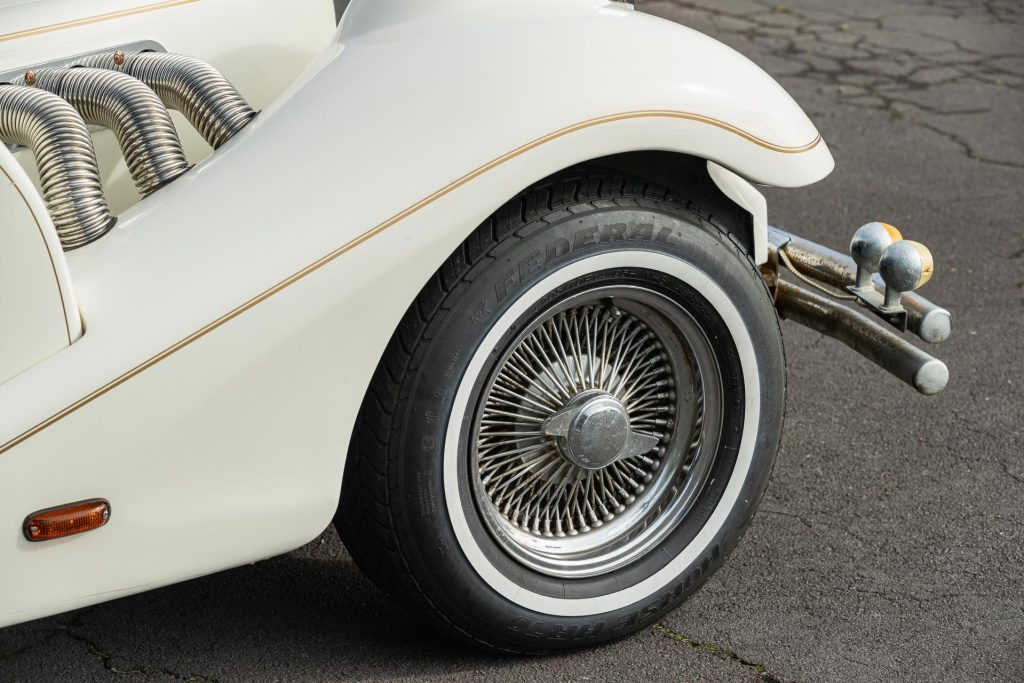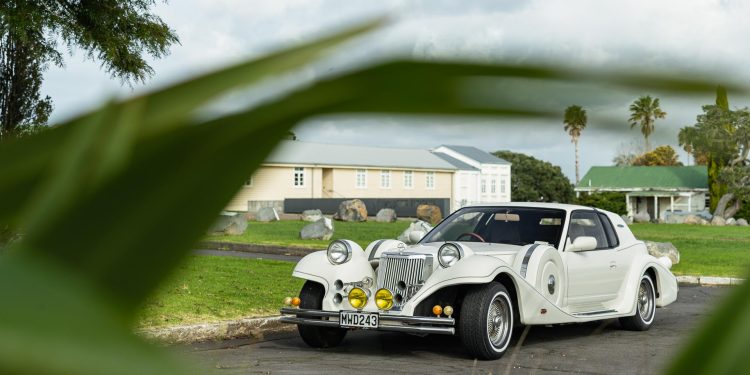1990 Mitsuoka Le-Seyde
Words: Kyle Cassidy | Photos: Isaac Western
Some cars attract attention, and then there is the Mitsuoka Le-Seyde. It’s out there man.
Japanese automakers have been responsible for a fair few four-wheeled wheeled oddities over the decades. There’s the Suzuki X90, Toyota Sera and Daihatsu Midget from recent memory.
They also outdo themselves with weird nameplates; the Daihatsu Naked, Suzuki Mighty Boy, Nissan Cedric and the Mazda Bongo Friendee, a van close to our hearts here.
But there is one manufacturer that stands above them all when it comes to the weird and wonderful, Mitsuoka. While not familiar to all, Mitsuoka is a fully-fledged Japanese manufacturer, registered in Japan back in 1994.

Susumu Mitsuoka founded the company in 1968. Its roots lie in a repair shop for rare imported cars, particularly British marques.
The story goes that a customer brought in a Euro microcar for repair and Mitsuoka san was inspired to produce his first car, the Bubu 50.
This looks like a crash helmet on wheels, with room for one while the 50 refers to the cubic capacity of the engine.

In the nineties, Mitsuoka made the Zero1, taking an Mazda MX-5 and morphing it into a Lotus 7 look-alike.
It is deemed to be Mitsuoka’s first car as a manufacturer. The firm has produced a dozen or so models over the decades since, including the aquatic-looking Orochi, a mid-engined GT sort of machine.

Its cars are based on existing platforms, with Mitsuoka’s unique take on design crafted onto them.
As the Mitsuoka website says, (we paraphrase here following translation) ‘the craftsmen spend around 40 days on each car, with just one or two units completed each day due to the hand-made nature of the process’.

Mitsuoka says “It is not an industrial product but a beautiful work of art”.
The firm’s current line-up kicks off with the Buddy, a RAV4-based SUV that wears front and rear styling influenced by the Chevrolet K5 Blazer. This is something you’d actually consider buying for it looks genuinely retro cool.
The Rockstar is MX-5 based, with styling akin to a C2 Corvette, albeit with typical Mitsuoka details. The Himiko is also MX-5 based but channels a Morgan-esque vibe, with an extended wheelbase and a long, exaggerated bonnet line and flowing guards.

Mitsuoka also has a couple of Nissan-based sedans on offer, the Galue and Ryugi, that wear Rolls Royce-like grilles. And the Viewt is now in its third generation.
This Micra-based mini Jaguar S-Type was first introduced in 1993, and still proves popular. With production numbers low, it seems Mitsuoka makes more money from its retailing and importation of high-end foreign makes. That then allows it to indulge in making dreams reality.

One of the company’s more outlandish designs is the Le-Seyde from the early 90s, the marvel you see here. Just 500 were made from 1990 to 1993 and legend says all build slots were snapped up in just four days.
The car is based on a Nissan Silvia S13 with styling that harks back to the uber-expensive machines from the roaring 20s and early 30s. We’re talking about Mercedes Benz SSK and Duesenberg SJ.
However, it also imitates the look of the Zimmer Golden Spirit and Excalibur, American ‘neoclassics’ from the eighties, with similar stylistic influences.


It’s out there, a real neck snapper. That’s not on account of its power but rather the look. It gets people taking a second glance, eyes agog, mouths agape, phones whipped out at the double.
Buy this if you like attention, for you will garner plenty of it. And from everyone, not just car people.
You really can’t pick its Silvia origins, at least from the outside for the interior is almost unchanged. But the exterior wears new fibreglass clothes, melded to the centre section of the S13.

Peering beneath the Le-Seyde, the extra length comes from a new subframe welded on to the front of the chassis, the rails having been extended quite substantially.
Whereas the wheelbase of the S13 donor car is around 2475mm, the Le-Seyde’s is 3375mm. That’s a lot of fibreglass and chrome added in front of the driver, while it measures up at just over 5.1m long.
Pop the long fibreglass bonnet and the Silvia’s four-pot engine is still nestled in its original position, up close to the firewall, but the front axle has been relocated north.

The extended steering column makes its way forward on an odd journey to meet back up with the rack, positioned much further forward than Nissan ever intended.
The engine is the naturally aspirated 1.8-litre CA18DE with 98kW and 159Nm of torque, matched to a four-speed auto sending the drive to the rear axle.
When seated behind the faux wooden wheel, you peer out down the long bonnet, the strange ornament marking out the end of the hood. The thing to remember however is there is still a good foot or so of the Le-Seyde in front of that again.

That wheelbase extension gives it a wide turning circle and, as the cabin is set well back, intersections can be a bit tricky to negotiate. The nose is already edging out into the traffic as you try to see what might be coming.
The steering response and feedback are a tad delayed with the extension; the front turns and then you have to adjust it on the fly to keep it on your intended path. It does feel slightly odd but not bad.
It rides okay too, the rear a touch firm over decent bumps but generally it feels like you’d expect an early nineties Japanese coupe to behave. The four-stage auto is slow and gappy but the four-pot still likes to rev.

And it needs to as it pulls the added weight. The S13 was around 1200kg whereas this is closer to 1400kg. A pity they didn’t opt for Nissan’s CA18DET; its 124kW and 228Nm would have been handy.
Being Japanese, it’s reliable; starting easily, all the electronics are still working, and it still feels well made. The cabin is quite fetching in its brown fit out, a mix of typical Japanese plastic and fabric.

And it’s all in great condition as this example has only covered 13,600km. The body is in good shape also, though the chrome work needs some attention.
Fancy yourself in one? This is for sale for $29,990 from Auckland’s North Shore Motors.
While the Le-Seyde was a limited run, the company couldn’t help itself and made a second-gen version in 2000 based on the S15 Silvia, the styling very similar to that of the original.

Perhaps the ultimate Le-Seyde is the drop-top model. Called the Dore, it’s based on a Gen-three Mustang, powered by the Windsor V8 but has the steering wheel on the left-hand side. It could well be the ultimate Japanese oddity.
Huge thanks goes out to North Shore Motors for providing us with the car for the afternoon.
This story first appeared in the July 2024 issue of NZ Autocar magazine.





